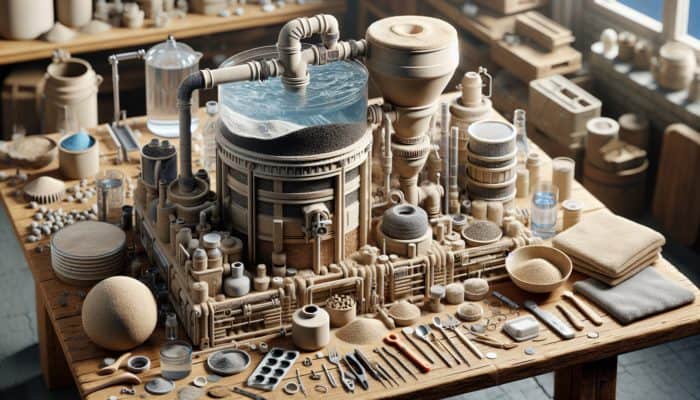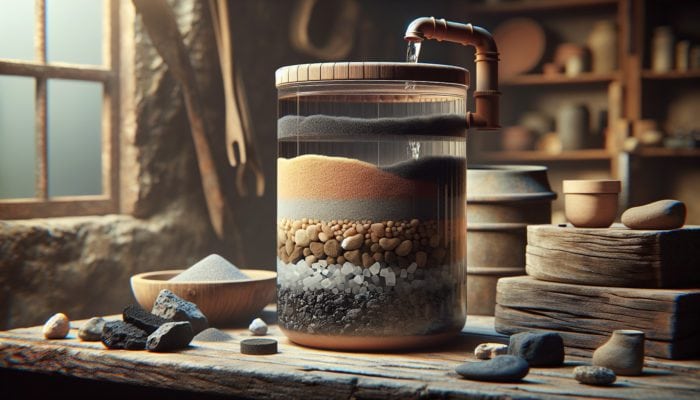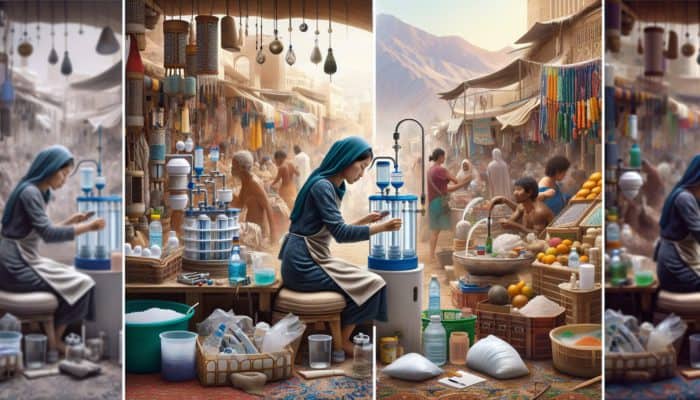Master the Art of Building Your Own Home Water Purifier
What Steps Are Involved in Creating a DIY Water Purifier?

DIY Water Purifier encompasses a variety of creative and practical techniques that individuals can utilise to construct their own water purification systems, ensuring that the water consumed is both safe and healthy. This DIY methodology encompasses a range of methods and materials aimed at addressing various purification challenges encountered in different environments. By grasping the foundational principles of these home systems, users can customise their solutions to suit local water quality, available resources, and specific health considerations. From straightforward sand filters to more sophisticated setups incorporating activated carbon and ceramic filters, a DIY water purifier acts as an adaptable tool for sourcing clean and safe drinking water.
The foremost advantage of a DIY Water Purifier lies in its versatility; designs can be modified to cater to environmental challenges and resource limitations. In areas where commercial purification options are scarce, the DIY approach not only empowers individuals but also promotes self-sufficiency. Consequently, the practice of building personal water purification systems has gained popularity worldwide, crossing geographical and cultural divides. By utilising local materials and traditional methods, individuals can craft effective water purification solutions tailored to their distinct circumstances.
Why Is It Beneficial to Create Your Own Water Purifier?
Embarking on a DIY Water Purifier project presents numerous benefits, the most prominent of which are cost-effectiveness and environmental sustainability. Commercial water purification systems can often be prohibitively expensive, particularly in developing regions. In contrast, DIY purifiers can be constructed using low-cost or even readily available materials, enabling individuals and communities to ensure access to safe drinking water without the financial strain associated with commercial options. Moreover, crafting your own system grants you complete control over the materials and techniques employed, encouraging eco-friendly practices that help mitigate unnecessary plastic waste.
In addition to financial advantages, engaging in DIY water purification also offers considerable educational benefits. Building these systems deepens one’s understanding of water quality issues and the science underpinning purification methods. This knowledge can empower communities to make informed decisions about their water sources. Furthermore, the independence gained from knowing how to purify water can significantly boost resilience against challenges such as water scarcity and contamination crises. Overall, DIY water purification serves as a potent tool for global empowerment.
Essential Principles for Effective Water Purification
Understanding the fundamental principles of water purification is crucial for the successful design and operation of DIY systems. The key processes involved include filtration, sedimentation, and disinfection, each playing a vital role in ensuring access to clean drinking water. Filtration entails the removal of particulate matter from water using barriers that capture debris, sediments, and microorganisms. In DIY configurations, this often utilises layers of sand, charcoal, and gravel, which serve as natural filters to effectively cleanse the water.
Sedimentation permits denser particles to settle at the bottom of a container, separating them from the clearer water above. This technique can be enhanced in DIY systems by allowing the water to remain undisturbed for a period before progressing with further purification methods. Finally, disinfection is essential for eradicating pathogens that may persist post-filtration. This can be achieved through various techniques, including boiling, UV light exposure, or chemical disinfectants. Familiarity with these principles empowers DIY enthusiasts to develop effective systems tailored to their specific requirements.
Key Materials Required for Your DIY Water Purifier

When starting a DIY Water Purifier project, selecting suitable materials is imperative for achieving effective purification. Commonly utilised materials encompass sand, charcoal, gravel, and ceramic, each providing distinct attributes that enhance the purification process. Sand acts as the primary filtration medium, adept at capturing larger particles and sediments, while activated charcoal is crucial for eliminating impurities and enhancing the water's taste. Gravel typically serves as a foundational layer, aiding drainage and reinforcing the filter’s structure.
Ceramic filters represent another valuable addition, offering a barrier that effectively removes bacteria and protozoa, making them especially beneficial in areas where these contaminants are prevalent. By combining these materials in layered configurations, users can optimise the purification process, resulting in cleaner and safer drinking water. Furthermore, sourcing materials locally not only reduces costs but also diminishes environmental impact, aligning with sustainable practices. As individuals undertake DIY projects, they can tailor their filters to address local water quality challenges.
Insights from Experts on DIY Water Purifiers
Success Stories of Effective DIY Water Purifiers
Globally, numerous inspiring examples of successful DIY water purifiers demonstrate the efficacy of straightforward yet innovative solutions. Communities in rural India, for instance, have effectively employed sand and charcoal filters to purify water sourced from polluted rivers, leading to a significant decline in waterborne diseases. Similarly, various regions in Africa have seen households construct low-cost ceramic filters using locally sourced clay, thereby improving access to safe drinking water.
- Sand and charcoal filters in rural India significantly reduce contaminants.
- Ceramic filters crafted from local clay in Africa improve water quality.
- Community initiatives in South America employ biosand filters for safe drinking water.
- Simple UV-based systems have been developed in Southeast Asia for pathogen removal.
- Rainwater harvesting systems combined with DIY filters in Australia promote sustainability.
- Mobile filtration units created in conflict zones offer immediate relief.
- Repurposed plastic bottles are used for filtration in disaster relief efforts worldwide.
- Educational programmes in the Philippines empower locals to build effective DIY systems.
These real-world examples not only showcase the accessibility of DIY water purification methods but also their adaptability to local contexts. Each narrative highlights how communities can effectively and sustainably address their unique water challenges. These success stories exemplify human ingenuity and underscore the potential of DIY water purifiers to significantly impact public health and well-being.
What Common Challenges Do DIY Water Purifier Projects Encounter?

While the DIY Water Purifier approach holds great potential, it is accompanied by specific challenges. One of the most pressing concerns is sourcing reliable materials. In many regions, access to essential components for effective filtration can be limited or unpredictable. This scarcity can lead to inadequate purification results if the materials used are unsuitable for the specific contaminants present in the water. Therefore, understanding local water quality and ensuring the availability of appropriate materials is critical for achieving success.
Another common challenge involves maintaining consistent purification efficiency. Over time, the materials employed in a DIY system may become saturated or contaminated, necessitating regular maintenance and replacement. Without proper care, the filtration system may become less effective, posing potential health risks. Additionally, many individuals may lack the technical knowledge needed to optimise their designs or troubleshoot problems encountered during operation. Fortunately, workshops and educational programs can provide guidance and support, equipping DIY enthusiasts to effectively navigate these challenges.
How Can Experts Enhance DIY Water Purification Methods?
Experts play a vital role in advancing DIY water purification methods through research and the development of new materials and designs tailored to specific environmental conditions. For instance, innovations in nanotechnology could yield filters that are more efficient at removing contaminants at a molecular level. Moreover, educating individuals about best practices for water purification—such as routine monitoring, maintenance, and testing—can significantly enhance the effectiveness of DIY systems.
Collaboration between scientists and local communities can also foster innovative solutions. By gaining insights into the unique challenges faced by different populations, experts can provide targeted recommendations and designs that address local water quality concerns. These partnerships not only improve the reliability of DIY purifiers but also cultivate a sense of ownership and responsibility within communities. Ultimately, experts can bridge the gap between scientific knowledge and practical applications, empowering individuals to develop effective and sustainable water purification solutions.
What Advantages Do DIY Water Purifiers Offer?
The advantages of DIY water purifiers extend far beyond mere cost savings. Firstly, they empower individuals and communities with a sense of control over their water quality. By constructing their purification systems, users are enabled to take charge of their health and well-being. Additionally, these systems frequently utilise locally available materials, making them accessible to a broad range of people, regardless of their economic status.
Furthermore, the educational value inherent in the construction of a DIY purifier cannot be overstated. Participating in the process cultivates a deeper understanding of water quality issues and the science behind effective purification techniques. This knowledge can lead to informed decision-making and proactive approaches to water management. Environmentally, DIY systems promote sustainability by reducing reliance on bottled water and minimising energy-intensive purification methods. Overall, the DIY approach resonates with a growing global movement toward self-sufficiency and environmental responsibility.
Essential Materials and Tools for Your DIY Water Purifier
What Are the Key Materials Necessary for Your Water Purifier DIY Project?
Constructing an effective DIY Water Purifier project necessitates a range of essential materials to ensure efficient filtration and purification. Fundamental components generally include sand, charcoal, gravel, and containers. Sand functions as a primary filtration medium, effectively eliminating larger particles and sediments from the water. When selecting sand, it is crucial to choose the appropriate grain size to optimise filtration effectiveness.
Charcoal, particularly activated charcoal, is indispensable due to its ability to adsorb chemicals, impurities, and odours, thereby enhancing both the taste and safety of the water. Additionally, gravel is vital for drainage and structural support within the filtration system. By layering these materials correctly, users can augment the purification process and yield cleaner water. Some DIY systems may also integrate additional elements, such as ceramic filters or mesh screens, to further refine the filtration process. Ultimately, the selection of materials should be guided by the specific water quality challenges encountered in a given region.
What Tools Are Essential for Constructing a DIY Water Purifier?
Having the appropriate tools is crucial for the successful assembly of a <a href="https://survivalbite.com/homemade-water-purifiers-essential-diy-solutions/">DIY water purifier</a>. Basic tools typically include drills, saws, measuring instruments, and containers. Drills are essential for creating openings in containers, facilitating proper water flow and drainage. Saws may be necessary to cut materials to the correct sizes, ensuring that all components fit together securely.
Measuring instruments such as rulers and measuring cups are vital in ensuring that the layers of materials are proportioned accurately, maximising the effectiveness of the filtration system. Furthermore, possessing safety gear like gloves and goggles is essential to protect oneself while working with tools. By equipping themselves with the necessary tools and safety equipment, individuals can confidently embark on DIY water purification projects, achieving successful outcomes.
Where Can You Source Materials for Your Water Purifier DIY Project?
Identifying reliable sources for DIY Water Purifier materials is vital for anyone looking to construct their purification systems. Common sourcing options include local hardware stores, which typically carry essential components such as sand, charcoal, and gravel. Additionally, online marketplaces offer a convenient platform for purchasing specific materials that may not be readily available in traditional stores. Repurposing and reusing household items can also be an effective way to source materials, such as utilising old plastic containers for the purification system.
Community initiatives or local NGOs often organise workshops or supply drives, providing materials for DIY water projects and promoting collaboration and knowledge sharing among participants. Building connections within the community can reveal alternative sourcing options and facilitate resource pooling for larger-scale projects. By tapping into these various avenues, individuals can ensure they have the necessary materials to create effective and sustainable water purification systems.
How Do You Prepare Materials for Your DIY Water Purifier Project?
Preparing materials for a DIY Water Purifier project is a critical step that ensures optimal filtration performance. This preparation typically involves cleaning and sizing materials such as sand, charcoal, and gravel. For sand, it is essential to wash it thoroughly to remove any dust or impurities that could compromise the final water output. Rinsing sand under running water can help achieve the necessary clarity and effectiveness.
Charcoal, especially if using activated charcoal, should also be cleaned to eliminate any fine dust that may negatively affect water quality. Sifting through gravel ensures that larger stones or debris are removed, promoting better drainage and flow within the filtration system. After cleaning, materials should be appropriately sized, as varying grain sizes can influence filtration efficiency. Proper material preparation not only enhances the purification process but also promotes the longevity and reliability of the DIY water purifier.
What Safety Measures Should Be Followed When Working with Materials and Tools for Your DIY Water Purifier?
Prioritising safety during the construction of a DIY Water Purifier system is essential. Firstly, individuals should always wear protective gear, such as gloves and goggles, to minimise the risk of injury while handling tools and materials. Many of the materials involved can be abrasive or harmful upon contact with skin or eyes, making these precautions critical.
Moreover, it is important to work in a well-ventilated area, particularly when using materials that may produce dust or fumes. Keeping tools organised and maintaining a clean workspace can help prevent accidents and mishaps during construction. Finally, closely following assembly instructions and ensuring all components are securely fitted will mitigate any risks associated with a poorly constructed system. By adhering to these safety precautions, individuals can confidently build their DIY water purifiers while minimising the risk of injury or accidents.
A Comprehensive Guide to Constructing Your Water Purifier DIY
How to Effectively Assemble the Core Components of a DIY Water Purifier?
Assembling the core components of a DIY water purifier requires a systematic approach to layering materials that facilitate effective filtration. The first step is to select a suitable container, such as a large plastic bottle or bucket, which will serve as the filtration unit. Begin by drilling holes at the bottom for drainage; this ensures that water flows through the filter when poured.
Next, create a gravel layer at the base, approximately one to two inches thick, to provide structural support and initial filtration. Above this gravel layer, add a thicker layer of sand, ideally five to six inches, which will trap larger particles and sediments. Finally, cap off the sand with a layer of activated charcoal, around two to three inches thick, which is essential for removing impurities and chemical contaminants. Each layer should be gently packed down to establish a stable filtration system. This layered structure optimises water flow, ensuring that all contaminants are effectively captured during the filtration process.
- Select an appropriate container and drill drainage holes at the bottom.
- Incorporate a gravel layer (1-2 inches) for structural support.
- Add a sand layer (5-6 inches) above the gravel for sediment filtration.
- Top with activated charcoal (2-3 inches) for chemical purification.
- Ensure each layer is evenly distributed and compressed.
- Cover the top of the filter to prevent contamination.
- Insert a clean collection container to gather the purified water.
- Allow the system to rest for a few hours before use to ensure stability.
After assembling these components, testing the system before regular use is vital. By pouring contaminated water through the filter, users can assess the clarity and quality of the output, allowing for necessary adjustments if needed. This hands-on experience not only empowers individuals to create effective purification systems but also enhances their understanding of water quality management.
How to Test and Enhance the Efficiency of Your DIY Water Purifier?
Testing and optimising your DIY water purifier is crucial to ensure that it functions effectively and produces safe drinking water. Begin by collecting a sample of water from the source you intend to purify. Pour this water through your DIY system and observe the clarity and odour of the filtered output. Noticing changes can indicate how well the system is performing and whether adjustments are necessary.
An effective strategy for enhancing the purification process is to experiment with different material combinations or ratios. For instance, if the water remains cloudy after filtration, increasing the sand layer or incorporating a finer grade could improve filtration efficiency. Monitoring the flow rate is also critical; if the water drains too slowly, it may suggest that the layers are too dense or that the materials require cleaning or replacement.
Regular testing of the purified water for microbial contamination or chemical residues can provide further insights into the system’s effectiveness. Utilising simple water testing kits can aid users in evaluating the safety of their drinking water. Through consistent testing and optimisation, individuals can ensure reliable, high-quality water purification tailored to their specific needs.
Maintenance Strategies for Your DIY Water Purifier
Regular maintenance of a DIY water purifier is essential for ensuring its longevity and effectiveness. A primary maintenance task involves cleaning the filtration materials periodically. Over time, sand, charcoal, and gravel can become saturated with contaminants, resulting in reduced filtration efficiency. To maintain optimal performance, users should replace or clean these components regularly, typically every few months, depending on usage and water quality.
Additionally, it is crucial to monitor the overall structure of the purifier. Inspect for any cracks or damage in the container, as these issues can lead to leaks or contamination of the purified water. Cleaning the collection container is also necessary to prevent bacterial buildup. Users should ensure that their purifier remains covered to avoid external contamination from dust or debris.
Moreover, maintaining effective water testing practices is vital. Regularly testing the output water for contaminants can help users determine when maintenance is necessary. By following these maintenance strategies, individuals can ensure their DIY water purifiers operate effectively, providing safe drinking water over extended periods.
Selecting the Optimal Materials for Your DIY Water Purifier
Choosing the right materials for a DIY water purifier is critical to its overall efficiency and reliability. First, consider the quality of water that requires purification. For example, if the source water contains high levels of sediments or larger particulates, a coarser sand or gravel may be necessary to effectively capture these contaminants. Conversely, for water with chemical impurities, activated charcoal is essential, as it has proven effective in adsorbing various harmful substances.
In addition to sand and charcoal, the type of container used also impacts the efficiency of the purification process. Clear plastic containers allow sunlight to penetrate, which can assist in disinfection through solar treatment if sunlight is available. Furthermore, if the water source is known to be biologically contaminated, incorporating ceramic filters can provide an additional layer of protection against bacteria and protozoa.
The ultimate goal is to create a balanced filtration system that addresses specific water quality issues. Assessing local water sources, understanding contaminants, and selecting appropriate materials can significantly improve the effectiveness of a DIY water purifier. By doing so, individuals can ensure access to safe drinking water while promoting sustainable practices.
What Safety Precautions Should Be Observed When Building and Using a DIY Water Purifier?
Ensuring safety while constructing and using a DIY water purifier is essential to minimise potential health hazards. First, individuals should always wear protective gear, including gloves and goggles, when handling tools and materials. This precaution helps prevent injuries from sharp objects and exposure to dust or harmful substances.
When assembling the purifier, it is crucial to use clean materials to avoid introducing contaminants into the system. Ensure that all components are thoroughly cleaned and dried before assembly. During use, avoid tap water if its quality is uncertain; instead, test the source water first to evaluate contaminants. If unsure, boiling the water before it enters the purifier can provide an additional layer of disinfection.
After construction, monitoring the purifier’s performance is critical. Keep the purifier covered when not in use to prevent contamination from external sources. Regularly check the output water quality and be prepared to clean or replace filtration materials as necessary. By adhering to these safety precautions, individuals can confidently construct and utilise their DIY water purifiers while minimising health risks.
Research-Driven Benefits of DIY Water Purification
Implement Effective Strategies to Maximise the Benefits of DIY Water Purification
To fully leverage the benefits of DIY Water Purifier, individuals should adopt several effective strategies throughout the process. Begin with comprehensive research on local water quality challenges and identify the specific contaminants present in your water source. This information will guide the selection of suitable materials and purification techniques customised to your requirements.
Regular maintenance is another essential strategy; clean and replace filtration materials as needed to maintain efficiency. Additionally, engage in routine water testing using simple kits to monitor the quality of the output water. This practice not only provides peace of mind but also helps identify any necessary adjustments to the purification system.
Participating in community initiatives can also enhance your DIY efforts. By joining workshops, you can learn from experts and share knowledge with others. Finally, consider documenting your process and experiences, as this can provide valuable insights for others looking to build their systems and foster a collaborative learning environment.
What Health Benefits Are Associated with DIY Water Purification?
Utilising a DIY Water Purifier system can yield significant health advantages by effectively removing harmful contaminants from drinking water. This includes the eradication of bacteria, viruses, and protozoa that can lead to waterborne diseases, thereby contributing to improved public health outcomes. Furthermore, the elimination of heavy metals and dangerous chemicals enhances water safety, reducing the risk of long-term health complications associated with consuming contaminated water.
An improved taste and odour resulting from effective purification processes can also encourage better hydration habits. When water is clean and palatable, individuals are more likely to consume adequate amounts, supporting better overall health. Additionally, the assurance of water safety contributes to mental well-being, alleviating concerns regarding water quality. In summary, DIY water purification systems serve as an accessible means to enhance health through improved water quality.
What Is the Environmental Impact of DIY Water Purification?
The environmental impact of utilising DIY Water Purifier methods is overwhelmingly positive. By creating homemade purification systems, individuals can significantly decrease their reliance on bottled water, thereby addressing the plastic waste crisis. The production and disposal of plastic bottles contribute to environmental degradation, and employing DIY methods fosters sustainability by minimising waste.
Moreover, DIY systems often rely on locally sourced materials, resulting in a smaller carbon footprint compared to commercial water purification systems that require extensive manufacturing and transportation. Implementing natural filtration techniques aligns with eco-friendly practices, promoting a more sustainable approach to water management. Overall, adopting DIY water purification contributes to healthier ecosystems and encourages environmental stewardship, motivating communities to engage in sustainable practices that benefit both people and the planet.
Innovative Approaches to DIY Water Purification
Expert Insights on Cutting-Edge Filtration Techniques
Within the realm of DIY water purification, various advanced filtration methods can significantly enhance the effectiveness of homemade systems. Reverse osmosis is one such technique that employs a semipermeable membrane to eliminate a wide range of contaminants, including salts and heavy metals. Although typically more complex to implement in DIY settings, adaptations of this technology can be explored for those willing to invest time and resources.
Ultraviolet (UV) purification is another advanced approach that utilises UV light to destroy or inactivate pathogens found in water. Integrating UV disinfection into a DIY system can provide an extra layer of safety, especially in areas experiencing high biological contamination. Utilising solar-powered UV lamps can make this method particularly accessible for off-grid communities.
Ion exchange is also noteworthy, particularly for removing hardness ions and heavy metals from water. This process involves exchanging harmful ions in water for less harmful ones, significantly improving water quality. While ion exchange typically requires commercial resin materials, creative DIY solutions can be developed to adapt this technique for home applications. Overall, incorporating these advanced methods can elevate DIY water purification systems to higher levels of efficiency, ensuring access to clean and safe drinking water.
How Can You Combine Multiple Purification Techniques into a Single DIY System?
Integrating multiple purification techniques into one DIY water purifier can greatly enhance the overall efficacy of the system, providing comprehensive treatment for various contaminants. A successful strategy begins with layering different filtration materials; for instance, one might start with a gravel layer for heavy sediments, followed by sand for finer particles, and then activated charcoal for chemical removal. This approach not only captures a wide array of contaminants but also optimises the unique properties of each material.
Additionally, incorporating supplementary methods, such as UV purification or chemical disinfection, can further enhance water safety. For example, after the water passes through the filtration layers, exposing it to UV light for a set duration can effectively eliminate any remaining pathogens. Alternatively, adding a small amount of chlorine or iodine to the filtered water can provide additional disinfection, although it is essential to ensure proper dosing.
Ultimately, the objective is to create a robust purification system capable of addressing various water quality challenges. By thoughtfully integrating multiple purification methods, DIY enthusiasts can ensure a higher level of water safety and quality, making their systems resilient against a broad spectrum of contaminants.
What Does the Future Hold for DIY Water Purification?
The future of DIY Water Purifier initiatives appears promising, characterised by innovative designs and materials that enhance accessibility and efficiency. One significant trend is the emergence of smart technology, enabling users to monitor water quality and purification performance in real-time. Incorporating sensors and mobile applications can provide valuable insights, assisting users in making informed decisions regarding maintenance and system adjustments.
Furthermore, advancements in materials science may lead to the development of more efficient filtration media, such as nanofilters or biodegradable options, which reduce environmental impact while enhancing purification effectiveness. Portable and compact designs are gaining traction, making it easier for individuals and communities to access safe drinking water, regardless of their living situations.
As awareness of water issues continues to expand globally, DIY water purification initiatives may evolve to include educational programs that empower individuals with the knowledge and skills needed to address local water challenges. This community-focused approach will not only encourage innovation but also promote sustainable practices, ultimately contributing to a healthier planet.
Frequently Asked Questions
What Are the Most Effective Materials for DIY Water Purification?
The most effective materials for DIY water purification typically include sand, activated charcoal, and gravel, as they are adept at removing impurities, sediments, and contaminants through various filtration processes.
How Often Should I Replace the Materials in My DIY Water Purifier?
Materials in a DIY water purifier should generally be replaced every few months, depending on usage and local water quality. Regular maintenance is vital for optimal performance and safety.
Can I Use My DIY Water Purifier for All Types of Water Sources?
While DIY water purifiers can treat many water sources, it is essential to align the system with the specific contaminants present in the water to ensure effective purification.
Is Drinking Water from a DIY Purifier Safe?
Yes, water from a properly constructed and maintained DIY purifier can be safe to drink, provided that it effectively removes harmful contaminants and is regularly tested for quality.
What Signs Indicate That My DIY Water Purifier Needs Maintenance?
Indicators that maintenance is required include slow water flow, cloudy output, unusual odours, or visible contaminants in the purified water, indicating that materials may need cleaning or replacement.
Can I Combine Different Purification Methods in My DIY System?
Yes, integrating various purification methods, such as sand filtration with UV disinfection, can enhance the overall effectiveness of a DIY water purifier and address a broader array of contaminants.
What Safety Precautions Should I Take While Constructing a DIY Water Purifier?
When building a DIY water purifier, always wear protective gear such as gloves and goggles, operate in a well-ventilated area, and ensure all materials are clean to prevent contamination.
How Can I Test the Water Quality from My DIY Purifier?
Water quality from your DIY purifier can be tested using simple home testing kits that measure contaminants like bacteria, pH levels, and chemical residues, ensuring the water is safe for consumption.
Are DIY Water Purifiers Environmentally Friendly?
Yes, DIY water purifiers are often environmentally friendly, as they reduce reliance on bottled water and utilise locally sourced materials, minimising waste and carbon footprint.
Where Can I Find Resources to Help Me Build a DIY Water Purifier?
Resources for building a DIY water purifier can be found through online tutorials, community workshops, or educational platforms that focus on water sustainability and purification techniques.
Connect with us on X for more insights!
The post DIY Water Purifier: Simple Steps to Clean Water appeared first on Survival Bite.
The Article DIY Water Purifier: Easy Steps for Clean Water Was Found On https://limitsofstrategy.com

